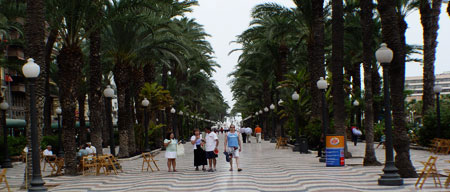Home > Study in Spain > City Guide > Alicante
Alicante City Guide
- Places of Interest
- Maps
- Getting to
- Getting around the city
With over 3000 years of history, Alicante is the capital city of the province of the same name and is located in the south east of Spain. Scattered with beautiful monuments and museums, it is recognised as the second largest city in the Valencian community with a very high population and one of the fastest-growing cities in the country.
The local economy relies heavily on tourism to the beaches of the Costa Blanca with its beautiful Mediterranean climate all throughout the year. Alicante is aligned with rows of stunning golden sandy beaches and calm, clear waters. San Juan being the most famous and is lined with beach bars and restaurants and also hotels within very close proximity.
The city also boasts a year-round nightlife with the large student population at the University of Alicante and is renowned for its vibrant festivals. 11 miles offshore, opposite the city of Alicante, is the small and beautiful Tabarca Island whose waters have been declared a Mediterranean Marine Reserve. This is definitely a must-do trip, if only for the day, and boat trips are easily made from Alicante.
Places of Interest
The Town Hall
Designed by architect Lorenzo Chápuli and built in the 18th century, the city's town hall is covered with stunning ornamental elements and lavish rooms inside including a chapel in which mass is held. There are also many works in the building by artists such as Padilla and Cabrera and at the foot of the building is the "Cota Cero", which is the reference point from which the altitude of Spain's various cities is measured in metres above sea level.
La Explanada
Being the most know and visited place in Alicante, this is the city's largest park. It is a stunning place to walk and is located next to the sea promenade with incredible views. Lined with palm trees, and small stalls, this park makes a stunning change from the beach if you fancy a little rest.
San Nicolás de Bari Cathedral
This small cathedral is one of the city's must-dos. With a baroque style and a garden with beautiful columns this little gem is certainly not to be missed out!
Santa María Basilica
This interesting church was built over the remains of a mosque and dates from the 14th to 16th century. In fact, it is the oldest church in the city and boasts an elegant baroque style. Features include the doorway with its image of the Virgin Mary and an 18th century rococo main altar.
Santa Bárbara Castle
This 16th century castle has sweeping views over the city of Alicante and is one of Spain's largest medieval fortresses at a height of 166 metres. The Castillo consists of an upper enclosure where the 14th century keep is located, a mid-level enclosure containing the most important buildings from the 16th century and the lower enclosure housing the 18th century Revelín del Bon Repós ravelin.
Museums
As much as Alicante is a popular beach resort for lovers of sea and sand, there are plenty of museums for those who prefer a more cultural visit and these wouldn't go amiss.
Fogueres Festival Museum
This explores the evolution of Alicante's most representative festival, the Hogueras de San Juan bonfire celebration held in June, which has been officially declared as of interest to international tourism. There are collections of "ninots indultados", mock bonfires, typical costumes and an audiovisual hall with past clips of the festival.
The bullfighting museum
Located in one of the buildings adjoining the city's bullfighting ring, here is housed a permanent exhibition on bullfighters from Alicante and is also a venue for various meetings, screenings and talks concerning the world of bullfighting.
Alicante Water Museum
Spread over 3 floors, this is a cultural and educational space where visitors can learn about the history of water in the city.
Beaches
The main reason for Alicante's high tourist population is its stunning beaches and warm climate. Across the city there are several beaches all with stunning characteristics.
Playa del Saladar
5 km south of the city centre, the golden sands stretch for over 1.5km and to the north there is a beautiful line of sand dunes. There is also an educational area for the mentally handicapped and an area with disabled access open during the summer.
Playa del Postiguet
In the city, at the foot of the Santa Barbara castle, this beach is renowned for the quality of its sand and is one of Alicante's most well-known attractions. There are zones reserved for playing sports, car parking spaces nearby, and an educational area for the mentally handicapped open in summer.
Playa de la Albufereta
To the northwest of the city lies this golden beach. It is a popular holiday spot amongst the local people of Alicante and is, in fact, where the city originated.
Playa de la Almadraba
This small pebbly beach with dark sand is popular due to its calm waters.
Playa de San Juan
This is Alicante's most famous beach as it has very high-quality sands and is located in an area with plenty of apartments, services and businesses. The beach is very close to the golf course with reserved areas for sport, bars and restaurants along the beach and also an educational area for the mentally handicapped open in summer.
Calas de Cabo de las Huertas
This beach is amidst rocks, sand and cristal clear waters. In a much more quiet area, this beach is away from the crowds and popular with nudists.
Playa de la isla de Tabarca
Located on Tabarca Island, this beach has cristal-clear waters, a picturesque fishing villaje and can be reached by boat from the port of Alicante.
Maps
Getting to Alicante
By Air
As Alicante is a tourist hotspot, it is very easy to get there and there are lots of options available. The Alicante Airport is located about 9km southeast of the capital and a bus running approximately every 40 minutes will take you into Alicante for about 1,25€ and shouldn't take more than 30 minutes. Another option is to fly into Madrid or Barcelona and get the train from both of those places as Alicante is well-connected to many cities throughout the country.
By Bus
The bus station in Alicante runs several lines with companies with links connecting Alicante both nationally and internationally.
By Train
Alicante has 3 train stations. Renfe is the main station and has both national and international connections, FGV is the train station for local and coastal destinations and finally, there is Murcia train station. The bus companies are called ALSA INTERNACIONAL, LINEBUS, STAR BUS and EUROLINES.
By Boat
Alicante can also be reached by ferry from many destinations with several departures throughout the day.
Getting around the city
If you stay in the old town, most areas are generally within walking distance however public transport is available with buses and trams. Buses run from early in the morning to late at night and there are also several night buses. Fares for tickets are approximately 1,20€ however the option of a rechargeable card is there also which works out cheaper overall and can be purchased at the TAM office near the Mercado station.

